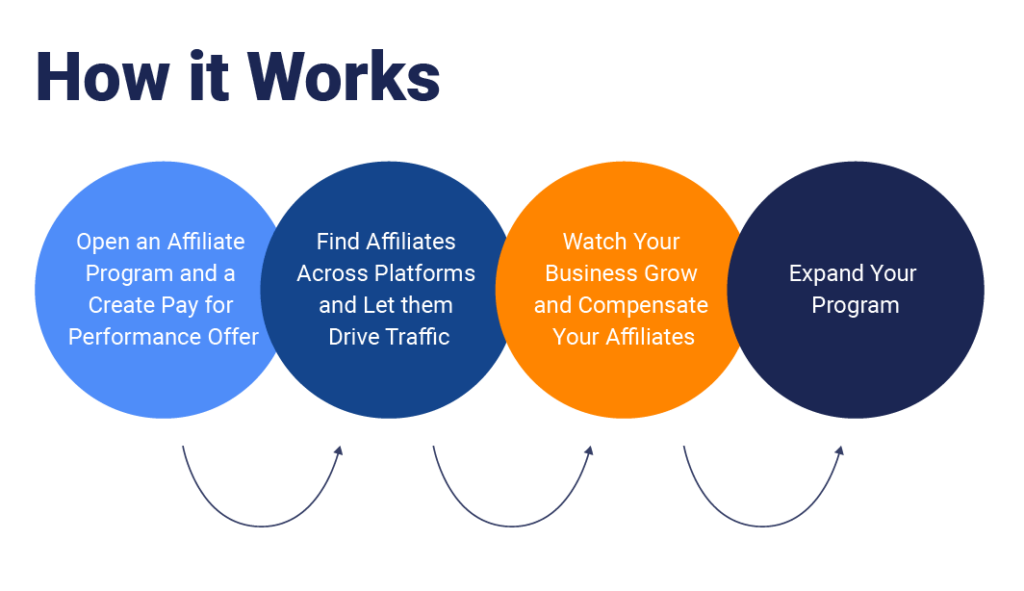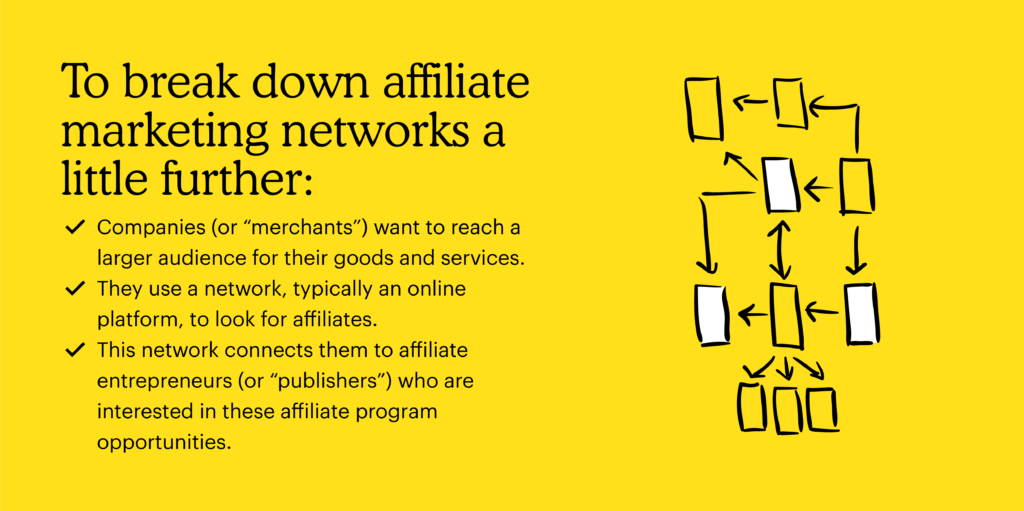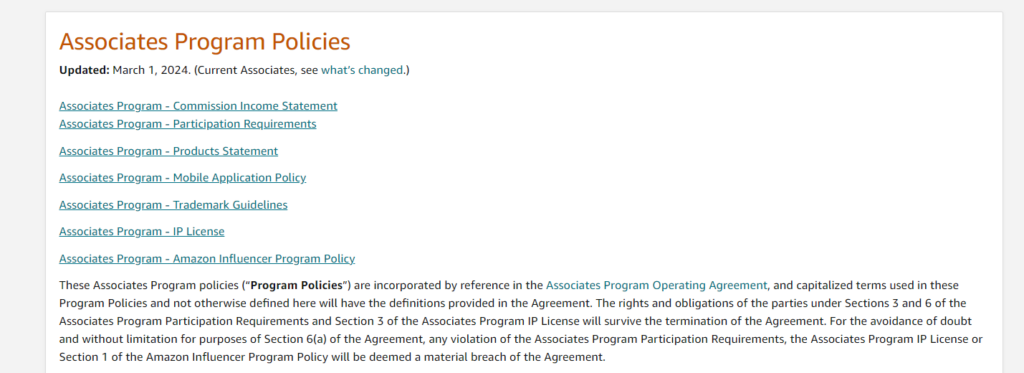Growing your business gets easier when you know the basics. Affiliate marketing is one of the most effective ways to generate sales and increase revenue without spending huge sums of money on marketing.
If you don’t want to spend money on marketing or you don’t have enough marketing budget, you should start an affiliate program.
Top brands generate 5-25% of online sales from affiliate marketing at potentially zero marketing cost.
Let’s explore how to get started with an affiliate marketing program and how to create one for your business in this detailed guide.
What is Affiliate Marketing?
It is a performance-based marketing approach where a business pays a commission to its affiliate partners for generating leads and sales. The partners (known as affiliates) run marketing campaigns on behalf of the business and they are paid a fixed commission per conversion.
Affiliates choose to promote your products and services to earn commission. They make money by selling products that they don’t own. Consider an Instagram influencer who has 10K engaged followers. A single post of an affiliate product can help him generate a few hundred dollars easily.
That’s instant money without creating, owning, and managing a product or business.
Affiliate marketing is a scalable and cost-effective marketing strategy that helps you generate sales at scale without spending any money on marketing. You only pay for successful conversions which significantly reduces your risk and you get sales at zero cost.
This makes affiliate marketing a win-win for both business and its affiliates.
Affiliate Marketing Statistics
Not sure if affiliate marketing is the right strategy for your business? The following affiliate marketing statistics are sure to change your mind:

- More than 50% of US marketers use affiliate marketing for the entire funnel due to its high efficacy. Around 49% of these marketers said that they’ll increase affiliate spending in 2023. (eMarketer)
- 81% of the businesses reported that they use affiliate marketing in some form (Rakuten)
- Affiliate marketing generates 12:1 ROAS which is one of the highest than most of the other marketing strategies and techniques (Rakuten)
- 65% of brands reported that 1-20% of their revenue is attributed to affiliate marketing alone (Martech Record)
- 50% of marketers, in a survey, reported that affiliate marketing is very effective and helps them achieve their business and marketing goals quite effectively (Gen3 Marketing)
- 54% of companies rated affiliate marketing as one of their top 3 marketing channels while 20% of brands rated it as their top channel for customer acquisition (Pepperjam)
- More than 50% of marketers rate affiliate programs as one of their top 3 revenue drivers whereas 19% rated it as their top revenue driver (Pepperjam)
- 75% of marketers say that affiliate marketing is either highly successful or successful at driving customer acquisition (Pepperjam)
- Enhancing loyalty efforts, high-quality customers, and performance transparency are the top 3 benefits that businesses generate via their affiliate programs (Pepperjam)
- 16% of all online orders in the US are attributed to affiliate marketing (Authority Hacker)
How Does Affiliate Marketing Work for Businesses?

Affiliate marketing for businesses works in 5-steps:
- Register with an affiliate network as a merchant or create your affiliate program in-house
- Recruit affiliates
- Affiliate marketers drive traffic to offers and generate sales
- You pay affiliates the agreed commission per sale/lead
- Repeat.
An affiliate network acts as an intermediary that connects merchants (businesses) with affiliate marketers. It tracks traffic, conversions, and pays affiliates for successful (verified) conversions. ShareASale is an affiliate network where both affiliates and merchants register. You can find affiliates and pay them by linking your payment method with ShareASale.

An affiliate network makes it easy for businesses to get started as it offers major benefits:
- Affiliate screening
- Transparency
- Tracking
- Payout management
- Advanced security.
When you recruit affiliates via an affiliate network, it is the responsibility of the network to ensure that the sale is genuine and the commission is released after successful sale and verification. This makes it ideal for businesses as they don’t have to spend any resources on tracking, screening, chargebacks, and affiliate fraud.
How to Create an Affiliate Marketing Strategy for Your Business
If you want to grow your business with affiliate marketing, you need to develop a robust affiliate marketing strategy. Here’s how to get started with it:
Step #1: Define Goals
What do you want to achieve with affiliate marketing?
Not all businesses want their affiliates to generate sales. In the case of a B2B business, you’ll need to focus on getting qualified leads from your affiliates. You can choose from a variety of objectives depending on your business model and other variables.
Here is a list of the most common performance-based objectives for affiliate marketing:
- Conversions: You can pay affiliates when traffic completes an action that’s important for your business such as downloading an app, installing an app, file download, form submission, etc.
- Leads: Affiliates are paid based on leads they generate.
- Sales: Affiliates get a commission for generating successful sales for your business.
You have to set clear objectives which should ideally be focused on generating sales. Here’s an example of an affiliate marketing objective: To generate 500 sales per month for the next 4 months.
Follow these best practices for setting clear, formal affiliate marketing objectives:
- Set objectives that are consistent with your business strategy and target audience
- Use the SMART technique to set goals
- Focus on sales or leads as these are the two most valuable performance-based objectives.
Step #2: Create Affiliate Program Policy
Once you know what you want to achieve with affiliate marketing, the next step is creating affiliate program policies. This is the official document that you share with your affiliates and it lists all the policies and terms.
Affiliate program policies are often overlooked by most businesses and they have to pay the price before they realize its importance. Policies help you avoid pitfalls of affiliate marketing such as:
- Fraudulent activities by affiliates
- Poor brand reputation and credibility when affiliates promote your product on marketing channels that don’t align with your brand strategy
- PPC bids on branded keywords
- Inconsistent brand messaging
- Commission rules
- Disqualification rules.
In simple words, affiliate policy tells affiliates what they can do and what they can’t do. Here’s an example from Amazon Associates where Amazon has listed all the policies for its affiliates and keeps updating it as per need:

Here’s another example from Fiverr’s affiliate policies:

Businesses usually confuse their own policies with the policy of the affiliate network. These are two different documents. It isn’t the responsibility of the affiliate network to safeguard your brand identity and set policies for you. It has its own rules and policies for affiliates and merchants that tell them what they can and can’t do on their network.
You have to set up affiliate policies for affiliates and publish it on your website. Share its link with your affiliates and keep them updated about the changes you make.
Here’s a list of what you should include and address in an affiliate policy:
- Affiliate marketing terms
- Participation eligibility
- Commission guidelines and fees
- Acceptable and unacceptable marketing and advertising channels
- Marketing limitations
- Brand, trademark, and style guide policies
- Termination reasons, policy, and rules.
You’ll have to tweak your policy document every now and then as you start using affiliate marketing. Don’t try to fit in everything now, you can always edit it as needed.
Step #3: Choose an Affiliate Network
After you have crafted and published an affiliate marketing policy on your website, it’s the right time to register with an affiliate network.
You have two options to set up your affiliate program:
- Create it in-house
- Use an affiliate network.
If you are new to affiliate marketing, you should sign up with an affiliate network as it is cheaper and manageable. Setting up your own affiliate program has a few pitfalls:
- It requires a lot of resources to set up and run an affiliate program
- The process is complicated as it requires advanced conversion tracking, payment management, screening, etc.
- It’ll get tough to recruit affiliates due to a lack of trust.
Affiliate network gives you instant access to affiliates which is a huge plus. You don’t have to find influencers, bloggers, and publishers, rather they’ll come to you.
Here’s a list of the top affiliate networks to choose from as a merchant:
- Awin: It has more than a million vetted affiliates to choose from. The starting price is $50 per month with a $549 joining fee. It comes with a free trial for a month that helps you figure out if it is the right network for your business. It supports both products and services across multiple niches.
- ShareASale: It is owned by Awin but operates as a standalone affiliate network. ShareASale has a $625 joining fee and a $35 monthly fee. You’ll also be required to deposit a minimum of $125 to pay affiliates. ShareASale works with almost all types of industries and supports both products and services with minimal restrictions.
- CJ: It is a leading affiliate network that supports a wide range of products across multiple sectors. CJ has custom pricing for advertisers which includes a network access fee and percentage of commission paid to the affiliates. You have to negotiate your deal with CJ which means you can end up paying less than other affiliate networks if you reach a decent agreement.
- Avangate: It supports digital products and software which makes Avangate ideal for SaaS businesses. You need to create an account on 2Checkout to get started with Avangate which means you have to use 2Checkout as your payment processor which has a starting price of 3.5% + $0.35 per successful sale.
- Rakuten Advertising: If you prefer to receive customized affiliate services, go with Rakuten Advertising. It might cost you a little more than other affiliate networks, but it pays off as you’ll get dedicated support. Pricing is customized and based on your requirements.
- Impact: It is a multipurpose platform that lets you manage affiliate and influencer marketing campaigns along with advanced tracking, attribution, and analytics. Impact works for physical products, SaaS, services, and pretty much any type of business and product. Pricing is customized and depends on what services you choose. The good thing is you can request a platform demo to check out how it works before signing up with them.
- FlexOffers: It is an ideal partner network platform for small businesses. FlexOffers has a $500 setup fee and you have to add $500 to your account for payouts. You have to pay a percentage fee based on the affiliate program you are running. It supports all types of products and business models so do check them out if you are starting out.
- ClickBank: It is a cost-effective and beginner-friendly affiliate network that supports both digital and physical products. ClickBank has a one-time setup fee of $49.95 and there isn’t any monthly fee. This makes it ideal for small businesses that want to try affiliate marketing without spending a big amount.
Research shows that an average high-earning affiliate uses up to 3 affiliate networks. It means you shouldn’t limit your offer to a single network, but rather sign up with multiple affiliate platforms to reach more affiliates.
Step #4: Screen and Recruit Affiliates
A major drawback of using affiliate networks is that you have little control over affiliates provided you give full control to the network. This tarnishes your brand reputation and therefore, must be tackled smartly.
You need to screen, onboard, and recruit the right affiliates whose business strategy aligns with yours.
When you register with an affiliate platform, you’ll instantly get access to all the publishers. You need to do two things:
- Disable auto-approval
- Ask screening questions from the affiliates such as their website or social account.
This will give you more control over publishers and you’ll be in a position to control your brand identity by managing who promotes your products, where they promote it, and how they market it.
Screening questions
Here are some screening questions you should ask affiliates:
- Their experience as an affiliate or publisher
- Website, social accounts, and other details
- What other offers do they promote
- Demographics of their audience
- What marketing channels do they intend to use
- Estimated sales they can generate per month.
These screening questions will help you identify the right publishers for your affiliate products.
Publisher onboarding
The successful affiliates should undergo the onboarding process so they get to know your brand and products better. This is an important step as it bridges the gap between affiliates and merchants. You need to consider them as your business partners which means they should know about your company, philosophy, strategy, culture, vision, and more.
Here’s a list of the key steps that should be a part of the affiliate onboarding process:

- Send a welcome email
- Share affiliate policy with new affiliates
- Assign affiliate manager to publishers
- Host a webinar or share a PDF with all your company details
- Share product details, buyer personas, top marketing channels, top sales channels, demographics, and other details in written form
- Allow affiliates to contact relevant managers via email and phone so you can address their concerns on time.
It is important to share all the relevant details that will help publishers generate sales.
Step #5: Track Traffic and Conversions
Monitoring conversions and sales is a core task that merchants have to perform daily. Don’t leave it all on the affiliate platform, you should monitor traffic, clicks, and conversions.
Most merchants look at the numbers and ignore other details. For example, you might get a lot of sales but it’s your responsibility to check if publishers are using allowed marketing channels and aren’t violating any terms.
Let’s take an example:
The top 3 traffic sources for affiliate marketers include SEO, social networks, and blogging. This means most affiliates will generate sales through organic traffic. You need to check out the search terms they are targeting.

Are these search terms really what you want your product to be associated with?
Are they writing fake, hyped reviews that’ll eventually impact your product and brand negatively?
Is messaging consistent with your brand?
Are they using spammy tactics and low-quality content to drive massive traffic?
Here’s an example of how publishers might end up ruining brand reputation and identity with poor placements:

Another example of an organic search result that has a negative impact on brand reputation:

Here’s another example:

These are affiliates who have used “Do not buy…” as clickbait to drive traffic. Does it hurt the merchant?
YES.
These are reviews that appear in SERPs and anyone who is looking for a review of the company will see these results and might turn away. Or, it’ll lead to a negative first impression.
Affiliates use catchy, unorthodox titles to drive organic traffic which often include words like:
- Scam alert
- Is ABC a scam?
- Do not buy before reading this
- ABC company: Legit or scam.
These and other similar titles negatively impact your brand and products.
Affiliate networks don’t check this. It’s your responsibility to inspect publishers, what they are doing, and how they are generating sales. This is a reason why you should have clearly defined affiliate policies and why regular monitoring is essential.
Step #6: Measure and Tweak
You’ll need to tweak your affiliate marketing strategy to improve its performance. You have to track multiple metrics to analyze how it’s working and what needs to be changed.
Research shows that total affiliate link clicks is the most tracked metric that brands use to track affiliate performance followed by conversion rate:

Most brands track affiliate program performance weekly followed by monthly and quarterly. It is a decent idea to track performance on a weekly basis to find and fix issues proactively:

Here’s a list of the major affiliate program metrics you should track:

- Traffic
- Traffic per affiliate
- Conversion rate
- Average order value
- Sales
- Customer lifetime value
- Customer acquisition cost
- Revenue
- Conversions per affiliate
- Sales per affiliate
- AOV per affiliate
- Commission vs. AOV.
You need to focus on publisher-related metrics and instead of tracking overall sales and revenue, track sales and revenue per publisher. It’ll help you identify top performers who you should retain.
Average order value per publisher is a key metric that tells you how much a referred customer spends with your brand. It helps you identify publishers who have understood your product’s USP and are pre-selling customers before sending them to your landing page.
You need to identify top affiliates and see what they are doing and how they are doing it.
Use their tactics to revise your affiliate strategy and policy.
You also have to identify low performing affiliates and figure out what techniques they are using. You’ll be surprised to see how affiliates game the system and generate fake sales and leads. Identify their tactics and update your affiliate policy accordingly.
Final Thoughts
Affiliate marketing isn’t a silver bullet. It requires a lot of experimentation and tweaks before it moves the needle. Finding the right publishers and then making them your brand partners is an essential part of an affiliate marketing strategy.
It takes time to find the right affiliates. You might have to sign up with several affiliate networks to find a few top publishers that work best for your business.
Once you develop a network of affiliates, it all gets easier.
The path to this destination isn’t as smooth as it seems. You have to invest a lot of resources to set up and manage your affiliate marketing program.
It’ll eventually pay off.
Featured Image: Pexels



